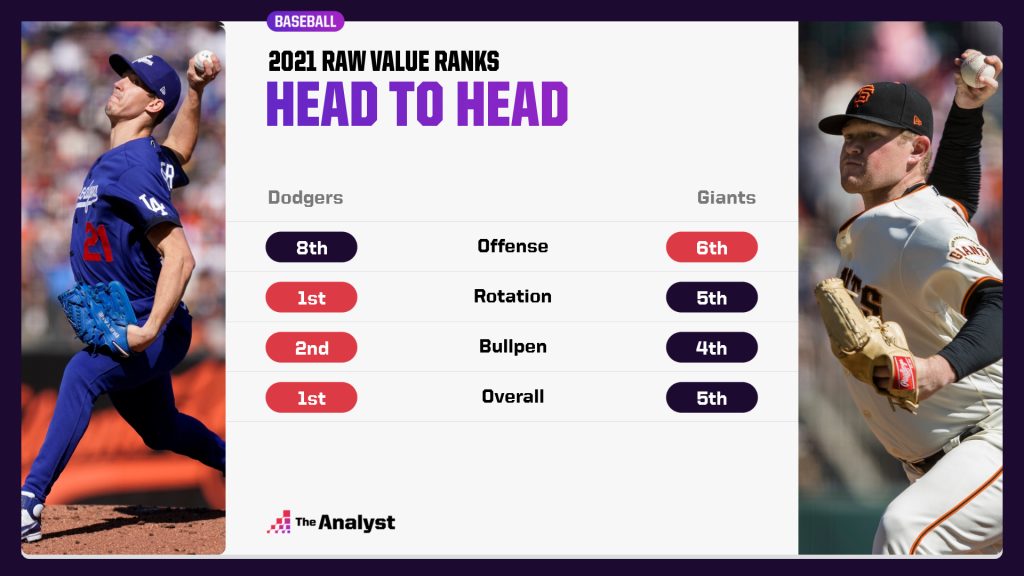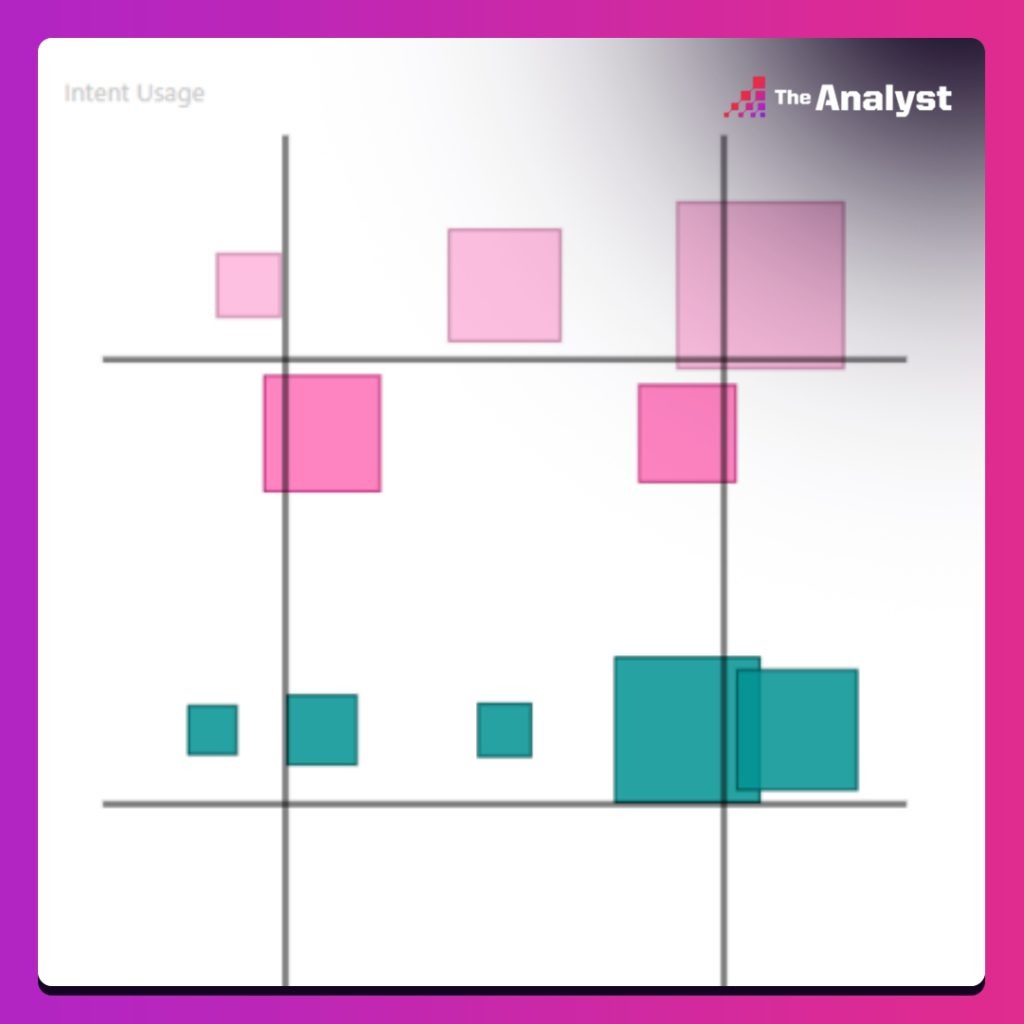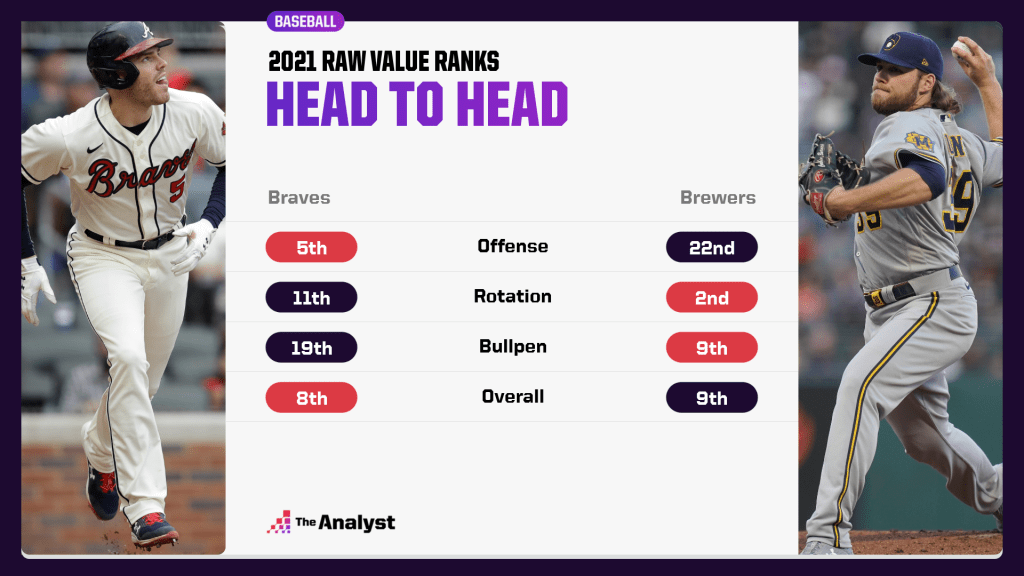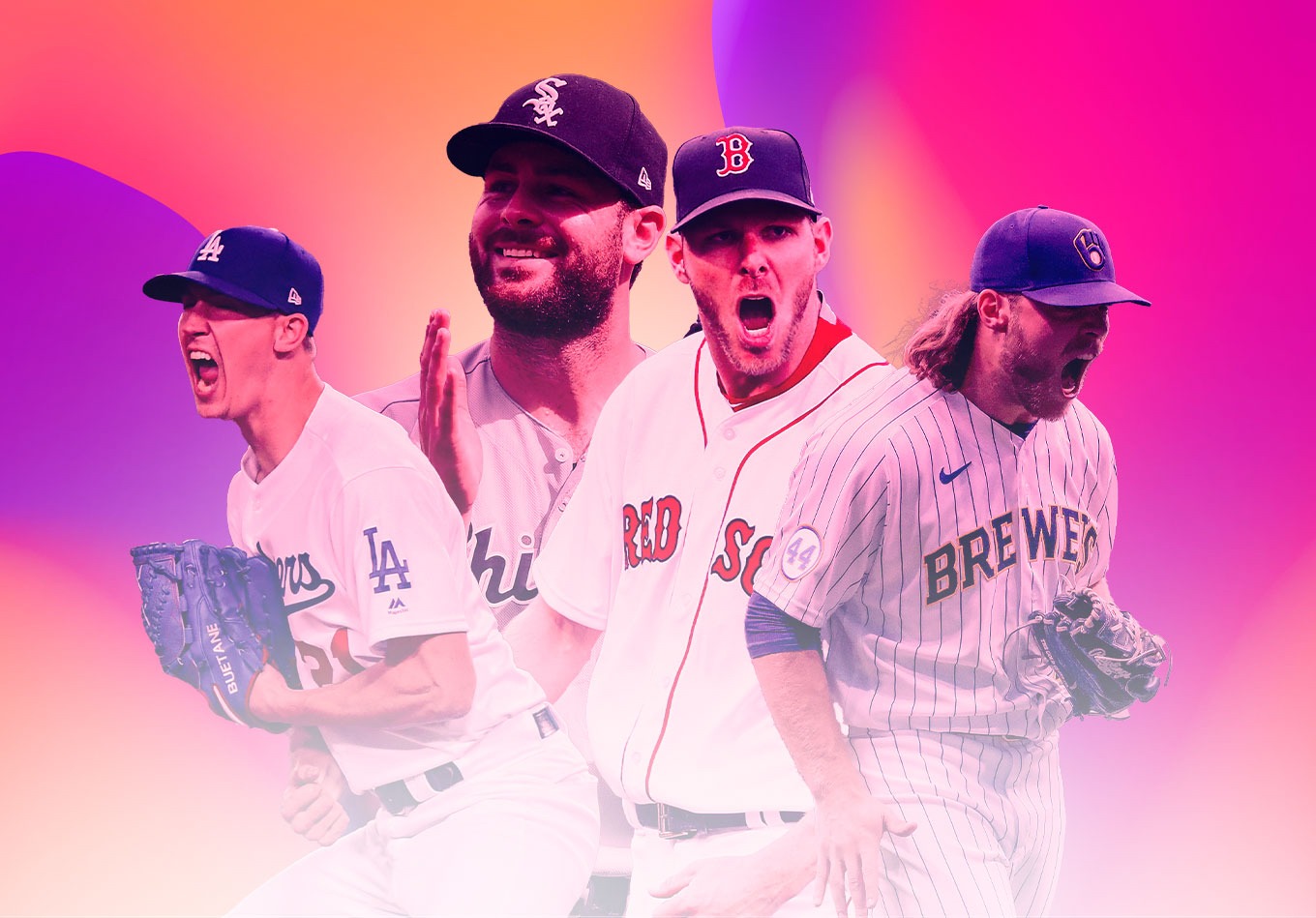We’ve spent the day examining Sale vs. Baz, Valdez vs. Giolito and Burnes vs. Morton with pitch type, velocity and location data. Next up: Webb vs. Buehler.
Young Arms, Old Foes: Webb and Buehler Meet in Giants-Dodgers Game 1
After taking down the Cardinals in the National League Wild-Card game, the 106-win Dodgers face their divisional rival, the 107-win, NL West champion, San Francisco Giants. This is the first time in MLB history in which two teams are facing off in the playoffs after each tallied at least 106 regular-season wins, so – yeah – expectations are high.

The story of the NL Wild-Card game was one of two veteran pitchers, each with significant playoff experience. When the Dodgers roll into Oracle Park Friday night for Game 1 of the Divisional Series, they will face 24-year-old Logan Webb as he makes his postseason debut. Opposing Webb is young Dodgers star Walker Buehler in a matchup of homegrown pitching talent.
Webb, who grew up in Rocklin, California, about 100 miles from San Francisco, aims to put the Giants ahead in the series and help them advance beyond the divisional round for the first time since their World Series win in 2014 by taking Game 1. Entering 2021 with just 94 career innings pitched, Webb will feature an occasional four-seam fastball, though he tends to rely on a three-pitch mix of sinkers, changeups and sliders. Likely owing to the prevalence of his sinker, Webb was second in baseball (minimum 130 IP) in ground ball percentage at 60.9%. Only Framber Valdez (scroll down to the first post of today’s blog) of the Astros ranked higher.
In 2021, Webb threw his slider 27.7% of the time. Against righties, that number jumps to 34.8%, and jumps again to 49.3% when he’s ahead in the count to righties. In conventional fashion, Webb looks to use his slider as an out pitch.
Webb’s slider has a whiff+ – an indicator of a pitcher’s ability to get swings and misses – of 132. This means he gets whiffs 32% better than league average. He’ll aim to use his ability to get whiffs with his slider to keep Dodgers righties such as Justin Turner and Trea Turner at bay. Opponents hit only .156 against Webb’s slider and had an OPS of just .428, the lowest of any of his pitches.
Continuing with Webb’s largely conventional pitching fashion, he leans heavily on his fastball when behind in the count, particularly to righties. Look for the Dodgers to try to capitalize on this and attack fastballs if Webb fails to get ahead of hitters and thus is unable to turn to his out pitch, the slider.
Logan Webb 2021 Usage Behind in Count
| Pitch Type | Behind in Count | Usage |
|---|---|---|
| Four-Seam Fastball | 13 | 6.4% |
| Two-Seam Fastball | 137 | 67.5% |
| Slider | 32 | 15.8% |
| Changeup | 21 | 10.3% |
In his three starts against Los Angeles in 2021, the Giants went 3-0. Although he failed to pitch more than six innings in any of the games, he only allowed four total runs and struck out 17 in 16 innings.
Dodgers third baseman Justin Turner has achieved the most success against Webb, going 3 for 7 with all three going for extra bases.
Dueling Webb will be the young gunslinger Buehler. Though only 27-years-old, this will be Buehler’s fourth postseason, having pitched in the playoffs in each of the last three years.
Velocity is the name of the game for Buehler. With a four-seam fastball that averages 95.4 mph and a cutter that sits at 91.8 mph, the Giants will have to be ready for speed if they hope to have success in Game 1. In addition to velocity, Buehler keeps hitters off balance by utilizing his deep arsenal of pitches.
His second most used pitch, the cutter (14.7% usage in 2021, mostly to lefties) was an excellent tool for Buehler to induce weak contact. His BIP+ on his cutter this year was 44, indicating that the quality of contact that hitters made against his cutter was 56% worse than average.
Once ahead in the count, he throws all six of his pitches (four-seam, two-seam, curve, slider, change, cutter) at least 5.9% of the time, and four of the six pitches (all except two-seam and change) at least 10.2% of the time.
When ahead in the count to lefties, Buehler likes to both keep his fastball away and to elevate it to get swings and misses.

Just as Webb handled the Dodgers, Buehler found impressive levels of success against the Giants this year. In six starts totaling 37 innings, he posted a 2.19 ERA and .973 WHIP. He allowed only two home runs.
In 23 career at-bats, Giants shortstop Brandon Crawford is hitting a paltry .174 against Buehler; however, Crawford went 3 for 10 against the lanky right-hander in 2021. Buehler also thrived against San Francisco backstop Buster Posey this year, with Posey only getting one hit in 11 ABs.
–ZD
Sale vs. Baz with a Side of the New Mr. October
Randy Arozarena is really making a strong pitch to be the new Mr. October.
After a breakout 2020 postseason that featured a rookie record 29 hits (including an MLB-record 10 home runs in a single postseason), he was back at it again in Game 1 of the ALDS. He scored a first-inning run to put the Tampa Bay Rays ahead, followed up by a home run later on and then perhaps his most daring act of all: a straight steal of home to bring Tropicana Field to life as his side cruised to a 5-0 victory with Arozarena becoming – well – we’ll let our research guys tell you:
All of this was supported by a fine starting performance from Shane McClanahan, who held Boston scoreless through five innings. This also meant Kevin Cash was able to spare some of his key relievers (Andrew Kittredge and Colin McHugh in particular) for another day.
And while the Red Sox will have been disappointed with their opening performance on the mound from starter Eduardo Rodriguez, Game 2 will see them turn to their ace Chris Sale against an even more inexperienced starting pitcher.
Let’s begin by looking at Sale who finally returned to the majors after a long layoff following Tommy John surgery. The 32-year-old made nine regular season starts upon his return in August, being gently eased back into action by Alex Cora but still accumulating 42.2 innings of work with a 3.16 ERA and a 5-1 record. One of those innings was the third immaculate innings of his career to tie the record set by Sandy Koufax.
The problems for Sale really came in his final outing of the regular season against Washington. When his team needed him most, the southpaw was only able to get through 2.1 innings of work and racked up 62 pitches in the process. That outing underlined the troubles Sale is having going through his usual repertoire, in particular the use of his changeup with most lineups seeing a steady diet of four-seamers and sliders.
Chris Sale’s 2021 Pitch Usage
| Pitch Type | Ahead in Count | Usage | Behind in Count | Usage | Even in Count | Usage | Full Count | Usage | Total | Usage |
|---|---|---|---|---|---|---|---|---|---|---|
| Four-Seam Fastball | 140 | 43.4% | 61 | 54.5% | 122 | 46.7% | 26 | 65.0 | 349 | 47.4% |
| Two-Seam Fastball | 3 | 0.9% | 3 | 2.7% | 4 | 1.5% | 10 | 1.4% | ||
| Slider | 134 | 41.5 | 19 | 17.0% | 71 | 27.2% | 8 | 20.0% | 232 | 31.5% |
| Changeup | 46 | 14.2% | 29 | 25.9% | 64 | 24.5% | 6 | 15.0% | 145 | 19.7% |
Even when reverting to his offspeed pitches, location against right-handers has proven to be an issue. As we can see from our TVL data, Sale prefers to get his pitches down and away. But his opponents are having success attacking these offerings, making contact over 50% of the time. Don’t be surprised then if Kevin Cash stacks his lineup with his best right-handed options (hello, Mr. October) near the top of the order and attempts to chase Sale out of the game early and put more pressure on the Red Sox bullpen.

In Sale’s major league career, he has thrown 1,672.1 innings. His opponent on the mound tonight has thrown just 13.1. But the 2021 season has been quite the climb for Shane Baz.
Let’s not forget, he was the PTBNL in that famous trade which saw Pittsburgh give up Austin Meadows, Tyler Glasnow and Baz for Chris Archer (who himself was part of the Rays rotation for fleeting moments this season). And he even started this season in Double-A ball with Montgomery. But his rise through the minor leagues has been quick, even resulting in pitching for the Olympic silver medal-winning Team USA in Tokyo, before making his first major league start on Sept. 20, halting the Toronto Blue Jays’ charge for a potential wild card spot with a win.
Having breezed through Miami, a first appearance at Yankee Stadium took a bit of the shine off his maiden run in the majors, but striking out 18 so far means he’s certainly going to be a challenge for the Red Sox’s hitter. He likes to live in the fast lane with a four-seamer that has averaged 97 mph in his major league career, but perhaps there’s an over reliance on it when behind or in full count situations. If Red Sox hitters can time themselves up, it could be their best shot at success in this one.
Shane Baz’s 2021 Pitch Usage
| Pitch Type | Ahead in Count | Usage | Behind in Count | Usage | Even in Count | Usage | Full Count | Usage | Total | Usage |
|---|---|---|---|---|---|---|---|---|---|---|
| Four-Seam Fastball | 37 | 47.4% | 28 | 58.3% | 38 | 57.6% | 5 | 83.3% | 108 | 54.5% |
| Curveball | 17 | 21.8% | 6 | 12.5% | 14 | 21.2% | 37 | 18.7% | ||
| Slider | 22 | 28.2% | 9 | 18.8% | 11 | 16.7% | 42 | 21.2% | ||
| Changeup | 2 | 2.6% | 5 | 10.4% | 3 | 4.5% | 1 | 16.7% | 11 | 5.6% |
So will it be the old(er) hand or the young gun who can fire their side to success in a vital Game 2?
–GB
Burnes Hopes to Continue His Dominance in Game 1 of the NLDS
While arguably the game’s best pitcher in 2021 faces the challenge of his first career postseason start, his counterpart has been in more than his share of playoff battles and will start for the 13th time in the postseason.
An intriguing pitching matchup takes center stage Friday in Game 1 of the National League Division Series between the NL East champion Atlanta Braves and the Central champion Milwaukee Brewers at American Family Field.

The Brewers are sending their best to the mound in Corbin Burnes (11-5, 2.43 ERA), who became the first Brewer in history to finish the season with the league’s lowest ERA, and he was also our NL pitcher of the year. Burnes has a 2.00 ERA over six career postseason appearances that all came in 2018, but he’ll be making the first playoff start of his four-year career.
He finished the 2021 regular season with a raw value- (RV-) of 32.2 and a whiff+ of 143.9 that led all of baseball. RV- examines how a pitcher performs throughout each pitch of an at-bat rather than just the result, while whiff+ measures a pitcher’s ability to generate swings and misses.
So what makes Burnes so tough? Well, part of the reason is that he never throws a traditional fastball. According to our TVL data, a majority – 52% – of his offerings are what we deem cutters, while only 10.6% of all his pitches are two-seam or four-seam fastballs. And those cutters are coming in at an average velocity of 95.2 mph – the highest in the majors among those who have thrown it at least 800 times – and with a spin rate that’s also the highest in all of baseball.
The right-hander uses that cutter to get ahead in counts (53.7%), aiming primarily for the low-and-away part of the zone to both left- and right-handed batters. And he’ll occasionally drop a curveball in there (23.6%) on a first pitch to keep hitters on their toes.
Corbin Burnes Intent on First Pitches

Keep a watch on how Burnes attacks lefties and righties differently with two strikes. Burnes still relies heavily on that cutter against lefties, throwing it 53.9% of the time. And after hitting the low-and-away part of the zone early in the count, he attempts to coax worrisome batters into chasing that pitch further out of the zone.
But against righties, he only throws the cutter 30.9% of the time and mixes in the curve (27.3%), slider (24.0%) and two-seamer (15.1%) a bit more. He’s looking to dive the curveball and slider down and out of the zone (away from the righties), and dart the two-seamer off the plate either down and away or down and in.
Corbin Burnes Intent with Two Strikes vs. Righties

Burnes had arguably his worst start of the season at Atlanta on July 30 when he allowed a season high-tying nine hits and five runs over four innings in a 9-5 win. Austin Riley homered off him in that contest and Dansby Swanson is 4 for 5 with two home runs lifetime in the matchup. Joc Pederson has had success against Burnes this season, going 3 for 5 with a double.
Atlanta’s Charlie Morton (14-6, 3.34 ERA) might not win any awards this season, but he’s one of those guys you want on the mound in a big playoff game. He’s 6-1 with a 2.27 ERA in his last nine postseason starts and had won five straight playoff decisions before taking the loss in Game 3 of last year’s World Series.
Morton is unique in that he throws his curveball (36.7%) more than any other pitch, even his four-seam fastball (36.2%). The right-hander uses the four-seamer slightly more (36.8-31.7%) on first pitches, but with two strikes that trend really switches around (47.4-38.8%).
Against lefties like Milwaukee star Christian Yelich, he’s almost primarily a two-pitch pitcher with the four-seamer and curve. But when facing right-handed batters, he adds a two-seam fastball to the mix (23.8%).
Morton pitched well in his only meeting with the Brewers this season, but he took the loss after allowing two runs and three hits over six innings on Aug. 1. Willy Adames took him deep in that contest for his only hit in nine career at-bats (four strikeouts) in this matchup.
That was the only time Morton has faced Milwaukee since the 2016 season.
–TB
White Sox Look to Take Flight Against Ground Ball-Inducing Valdez
The combination of Lance McCullers Jr.’s 56.4 ground ball percentage and the White Sox offense’s 46.1 ground ball percentage proved lethal in the Astros’ Game 1 win. He mixed his two-seam fastball and breaking balls well to keep the White Sox off the scoreboard for 6.2 innings.
The White Sox certainly will look to hit the ball in the air more today in Game 2. However, that will be a difficult task as the Astros turn to Framber Valdez, who has an even higher ground-ball percentage than McCullers Jr. at a demoralizing 70.3%. Where does that rank league-wide? Well, it’s the best in baseball at a minimum of 130 innings.
Valdez works in a similar fashion to McCullers Jr., relying on a two-seam fastball and breaking ball. The two-seamer dominates his usage at 53.3% with the curveball thrown 30.8% of the time. The finesse left-hander lives down in the zone to influence grounders.
Framber Valdez Pitch Intent

Using our TVL data, which tracks pitch type, velocity, location, and the intent (think target) of every pitch, we can see that Valdez targeted the bottom of the zone with 97.6% of his pitches this season. The rare exception is typically a four-seam fastball ahead in the count.
If there’s one way for White Sox hitters to get back on track though, it may help to be facing a left-handed starting pitcher. Over the last two seasons, the White Sox lead the AL with an .802 OPS against lefties. This season, that’s led by the middle of the order production of Luis Robert (1.235), Yasmani Grandal (1.031) and Jose Abreu (.969).
Valdez, however, has reverse splits though and works in offspeed stuff against right-handed batters. Left-handed hitters have a .717 OPS against him while right-handed hitters only managed a .626 OPS. Though his curveball has been his best pitch against both sides, he adds a changeup to keep hitters off balance. Out of 252 changeups thrown, 247 were to right-handed hitters.
Framber Valdez Pitch Types vs. Right-Handed Batters
| Pitch Type | Count Situation | Pitches | % |
|---|---|---|---|
| 4-Seam | Ahead | 11 | 2.1 |
| 4-Seam | Behind | 44 | 9.3 |
| 4-Seam | Even | 8 | 1.3 |
| 2-Seam | Ahead | 176 | 33.3 |
| 2-Seam | Behind | 312 | 66.2 |
| 2-Seam | Even | 363 | 56.7 |
| 2-Seam | Full | 36 | 56.3 |
| Curve | Ahead | 250 | 47.3 |
| Curve | Behind | 62 | 13.2 |
| Curve | Even | 169 | 26.4 |
| Curve | Full | 26 | 40.6 |
| Change | Ahead | 92 | 17.4 |
| Change | Behind | 53 | 11.3 |
| Change | Even | 100 | 15.6 |
| Change | Full | 2 | 3.1 |
In the regular-season series between these two teams, Lucas Giolito provided the kind of shift the White Sox will need today. After Houston took the first five games of the season series, Giolito helped get one back with a complete-game gem in a 10-1 win. The one run he allowed was on a sole home run by Abraham Toro, who is no longer with the Astros.
There are still a couple of Astros around with success against Giolito. Michael Brantley is 6 for 12 with two home runs lifetime in the matchup, and Jose Altuve is 3 for 10 with a pair of home runs as well.
Giolito has relied heavily on his changeup, throwing it 31.8% of the time. He throws it to either side of the plate, willing to leave it higher in the zone as hitters have trouble distinguishing it from his fastball. His confidence in the pitch allows him to throw it any count as well, actually increasing the usage when behind in the count.
Lucas Giolito 2021 Regular-Season Pitch Types
| Pitch Type | Count Situation | Pitches | % |
|---|---|---|---|
| 4-Seam | Ahead | 430 | 36.8 |
| 4-Seam | Behind | 311 | 49.5 |
| 4-Seam | Even | 499 | 49.4 |
| 4-Seam | Full | 63 | 38.2 |
| Curve | Ahead | 55 | 47.1 |
| Curve | Behind | 1 | 0.2 |
| Curve | Even | 29 | 2.9 |
| Slider | Ahead | 309 | 26.5 |
| Slider | Behind | 88 | 14.0 |
| Slider | Even | 219 | 21.7 |
| Slider | Full | 22 | 13.3 |
| Change | Ahead | 373 | 32.0 |
| Change | Behind | 228 | 36.3 |
| Change | Even | 263 | 26.0 |
| Change | Full | 80 | 48.5 |
That all said, Giolito actually strayed from his typical approach last time he faced Houston. The most drastic change was an increase in his fastball usage by 15% while the changeup rate decreased by 13.1. Although successful, we could see a more typical approach from Giolito this afternoon after the Astros showed yesterday why they’re the best fastball-hitting team in MLB.
–JL
Design by Matt Sisneros.
